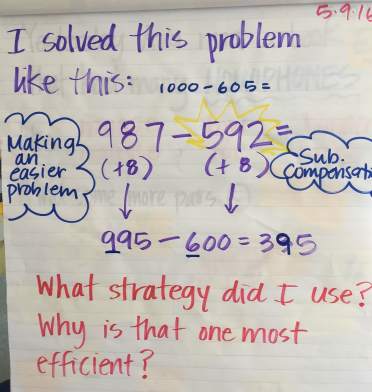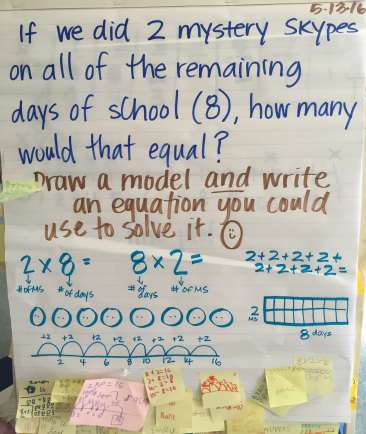What? This week I did MWUs every day? Partly that happened because we actually had every day this week at school, but also because I moved the MWU to a different time of day and it made the timing easier (sometimes mornings can get a little crazy and sometimes I have other things I need them to do instead). Now (at least for the time being), we’ve moved Writing Warm-Ups to the morning and Math Warm-Ups to right after lunch, and that conversation is then the beginning of our math time together (that part is still the same). Confused enough now? Don’t worry–the big deal is that I have FIVE MATH WARM-UPS TO SHARE!! They’re pretty great, too, so I’m glad you stayed through that long intro to check them out. 🙂
Monday
We have been working on subtraction lately, and my kiddos have started to do some amazing thinking with negative numbers as a means of figuring out differences. It started with just a couple of friends a couple of weeks ago and now probably at least half the class has tried it! The chart here is similar to the HTO model (which we called Sticks and Dots back then) we used in 1st grade, but connected to an investigation we did with the T-Shirt Factory and refers to the inventory of t-shirts. The come in Boxes of 100, Rolls of 10 and then loose ones. Same idea, but inside the context it makes much more sense. Like most times, you’ll see we did it using two other strategies, as well. The green numbers on top are from the strategy Making an Easier Problem, in this case by adding 11 to both numbers (which we know is possible because of the idea of constant difference).

We also tried it with Circle, Split, Subtract and modeled our thinking on a number line.

And check it out–we got 289 every time!
Tuesday
Another concept we’ve been playing around with is the inverse relationship between addition and subtraction. This one also asked them to analyze someone else’s thinking. We tried it by adding up…

…as well as with our negative number strategy. Again, we got the same answer both times!

Wednesday
On Tuesday during math, I gave kiddos a check-in sheet to see what they could do on their own with subtraction, now that we’ve been working on it for a while together, and the last problem was a challenge problem. Ok, it really isn’t that much harder (just another place), but I wanted to see what kiddos would do when I added 1000s to our work. Landen and Ava decided to that the BRL chart would probably work the same way if you just added another column, and suggested that we try it together as a math warm-up the next day. Great idea, kiddos!

Somehow I took my picture before we had done our work on the chart, so you can’t see it, but believe me–it worked just like they thought it would. Oh, and when I was using this chart again with someone later that day, we decided that instead of just T for thousands (which doesn’t fit the context of the t-shirt story), we’d say T was Trucks, because you could put 10 boxes on trucks.
Thursday
We’ve been working on both geometry as well as subtraction in math for the last couple weeks (and some still also on money from our last unit), but I decided that we’d use the MWU as the start for our conversation by throwing up some geometry vocabulary I needed to emphasize. So using examples and non-examples, I had them think about parallel:

They were able to figure out the meaning (for the most part), although many kept saying it meant “straight” and we had to clarify what they really meant, because ALL of those lines are straight….and while I don’t like math tricks, I did show them that in the word PARALLEL are clues to what it means: PARA for the PAIR of lines, and that the l’s make two parallel lines themselves (ok, well they do if they’re lowercase…see, told I don’t like tricks).
Friday
Today’s MWU was geometry again, related to work we’d done this week, as well as connecting to the work I knew I’d have them do during Math Workshop today. Win/win! (Oh, and I realize now I mislabeled the trapezoid as a parallelogram. Oops. I’ll fix that on Monday. 🙂 ).

After this conversation we went on a great shape hunt challenge outside, but you’ll have to wait about it. We’re not quite done yet. 🙂
Note: See that “next” on the bottom? I’d tried many versions of that extra question this week on math and writing warm-ups. It seems that when I put “bonus” there, kiddos thought that meant they didn’t have to do it. LOL So I tried “next” and also “big ?” to help them see that they could do both of them. Or at least start thinking about the answer, since it would be what we’d be talking about anyway.

















































